Up Next
The Cinematic Origins of Cindy Ji Hye Kim’s Ghostly Paintings on Silk
The Korean-Canadian artist’s fascination with the unconscious shines through in her double-sided translucent silk paintings
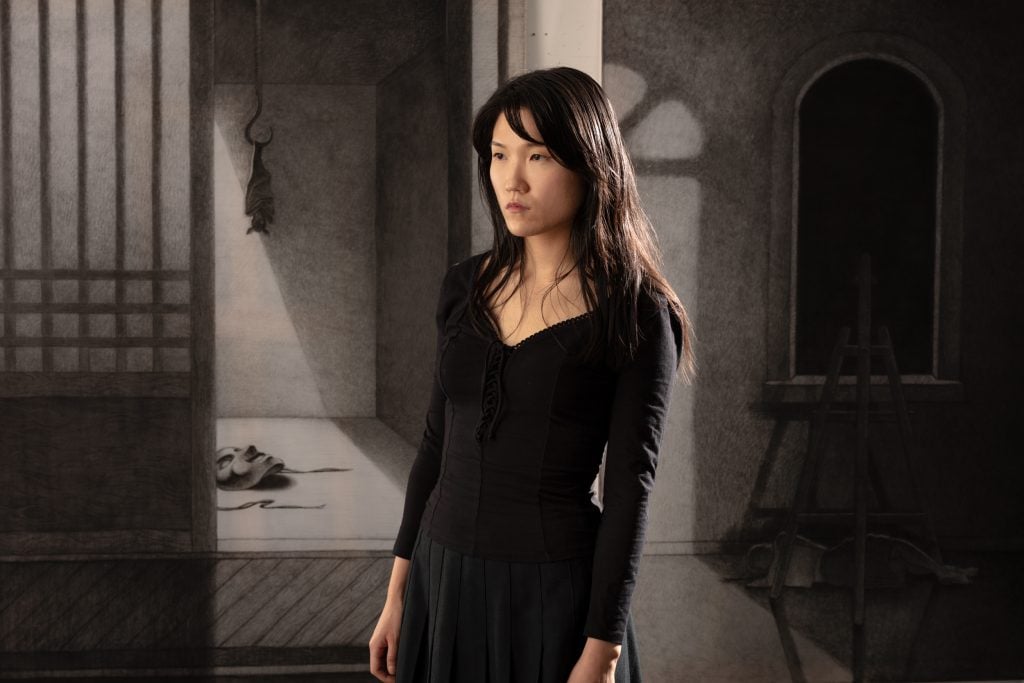
The Korean-Canadian artist’s fascination with the unconscious shines through in her double-sided translucent silk paintings

Stephanie Sporn

Films have played a pivotal role in helping Cindy Ji Hye Kim hone her fine art practice. “Learning about the Minimalist and Conceptual art movements was an eye-opening experience and made me question what it meant to make art,” the Korean-born, New York-based artist tells Artnet News of a Sol LeWitt documentary she watched as a RISD college student in the early 2010s. “I think that’s the moment when I became interested in ‘art,’ not as a final product of a series of techniques, but art as a rhetorical tool for questioning,” she said.
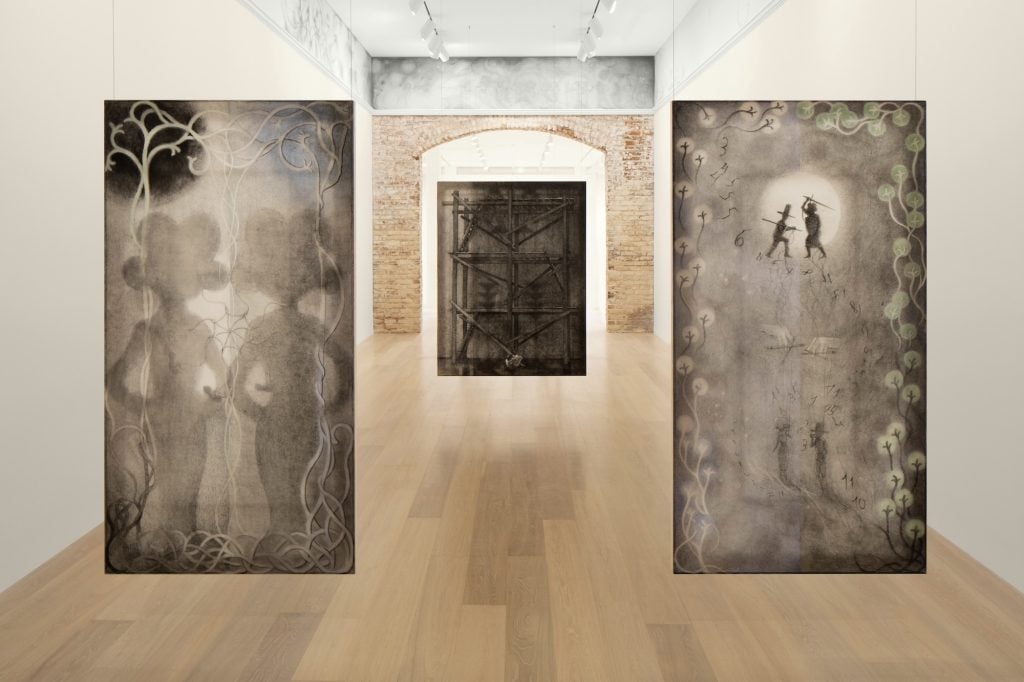
Installation view “Cindy Ji Hye Kim: Silhouettes in Lune” 2024. Courtesy of SCAD. Photography by Lance Brewer.
In the same way, LeWitt’s abstractions reveal his preoccupation with the passage of time, Kim’s paintings feel highly introspective, conveying both her personal “sense of longing and loss” (largely stemming from her move to Canada at age 12) and curiosity surrounding unconsciousness and the afterlife. While the conceptual artist’s works are deceptively simple, Kim’s dreamlike and ghostly œuvre is outwardly complex in its narrative subject matter and ingenious, illusive technique utilizing the architecture of the painting’s stretcher.
Kim’s interest in the intangible and obscure is also rooted in film, specifically, Michael Haneke’s 2000 movie Code Unknown. “It left a huge impression on me as a twenty-something-year-old,” said Kim, who checked out as many books as she could on the Austrian director and screenwriter, known for his unsettling style and provocative critiques of society. Through her research, Kim discovered radical directors, such as Andrei Tarkovsky and Pier Paolo Pasolini, and similarly psychologically charged novelists, including Franz Kafka and Fyodor Dostoevsky.
These filmmakers and writers’ exploration of Sigmund Freud’s theory of the unconscious proved revelatory for Kim: “Beneath the conscious mask of a man, Freud saw a heartless ape, whereas [Carl] Jung saw a wounded angel. Whichever way you see the unconscious, there’s a tension between the bodily and the spiritual, and I find that to be a productive place for me to occupy as an artist.”
SCAD Museum of Art curator Ben Tollefson praises Kim’s “suggestive, dynamic, and ethereal” works: “She possesses an incredible ability to construct striking imagery that connects to the transcendent human experience, whether through our spiritual inclinations or our deeply seated psychological desires and fears.” As part of the Georgia institution’s deFINE ART 2024 exhibition series, which kicked off in February, Tollefson conceived Silhouettes in Lune, a site-responsive show by Kim. On view through July 29, the installation includes paintings and sculptures situated in an elongated gallery, around which Kim has drawn a mural.
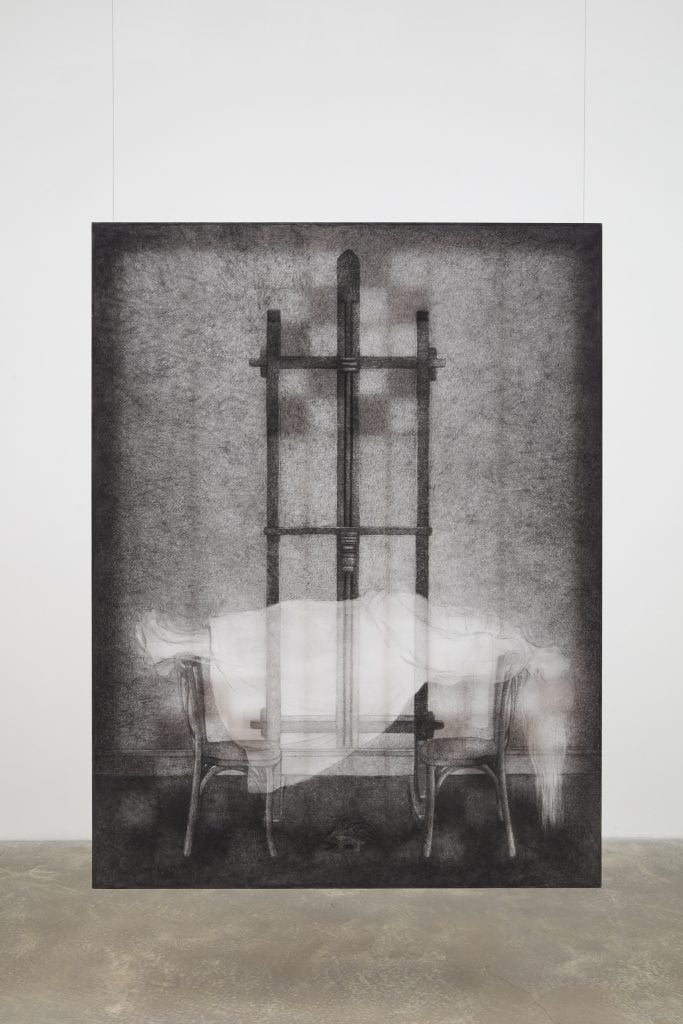
Cindy Kim, Principles of Closure (2023). Courtesy of SCAD. Photography by Lance Brewer.
“I was first struck by the tunnel-like quality of the space…there are brick arches at the entrance and the exit that also add to its unique character,” explained Kim, represented by Casey Kaplan in New York and François Ghebaly in Los Angeles. “I decided to install my double-sided silk paintings and wooden arches in the air to convey the sensation of moving through a threshold, akin to moving between the conscious and the unconscious psychic.”
As exhibitiongoers pass through the carved wooden arches and paintings suspended from the ceiling art can be seen from all angles. Behind every image—whether depicting a stationary easel or figures fighting in the moonlight—are intricately shaped stretchers on the opposite side. These structures’ silhouettes peer through the translucent silk, enhancing the shadows and shapes of Kim’s layered compositions. “The support structures have been a part of my visual vocabulary because I’m interested in their unseen labor of creative expression,” said Kim. “An easel supports a painting, scaffolds support a monument, a theater set supports a play.”
Kim’s mastery of her medium and her effortless oscillation between hyperrealist and cartoon-like iconography keep these stretcher mechanisms from approaching gimmickry. Rather, they serve as a highly clever vehicle that enhances her ominous storytelling through their spectral presence. In one painting, for example, a ghost-like woman in a seemingly transparent gown nearly levitates off of two chairs placed before an easel.
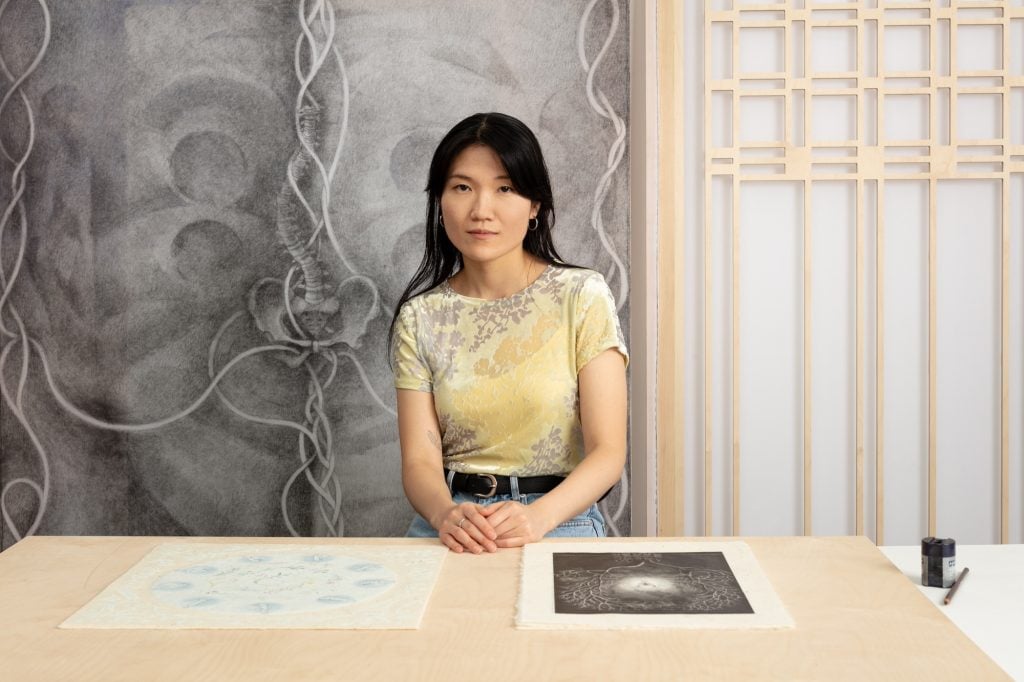
Cindy Kim, 2024. Courtesy of the artist. Photograph by Lance Brewer.
The paintings and surrounding frieze follow Kim’s preferred grisaille palette, a further nod to the unconscious. “Grisaille is a classical underpainting technique, often used as a blueprint, and I see it as the skeleton hidden beneath the flesh of color. It dictates much of what’s going on in the picture without being dominant, or even visible,” described the artist. “In my work, I see the grisaille palette as coming to light: the unconscious becomes conscious.”
The ambiguity and delicacy of her works may stem from Kim’s passion for contemporary Korean poetry by the likes of Choe Yeongmi and Kim Hyesoon. Though “their sensibility and emotive power cannot be translated into English,” Kim’s once eerie yet tranquil paintings transcend languages and can seem to transcend earthly barriers.
In addition to swirling clocks and numbers, Kim’s signature characters, “representing archetypes of masculine and feminine energy,” as she describes, comprise the gallery’s hand-drawn frieze. As evident here and in her recent solo show at Norway’s Kunsthall Stavanger, drawing installations has become a central part of Kim’s practice since her 2018 exhibition at Brooklyn gallery Interstate Projects (now closed) and her first institutional show at the MIT List Visual Arts Center in 2020. “These two shows continue to be my guiding compass and remind me of the importance of play and experimentation,” added Kim.
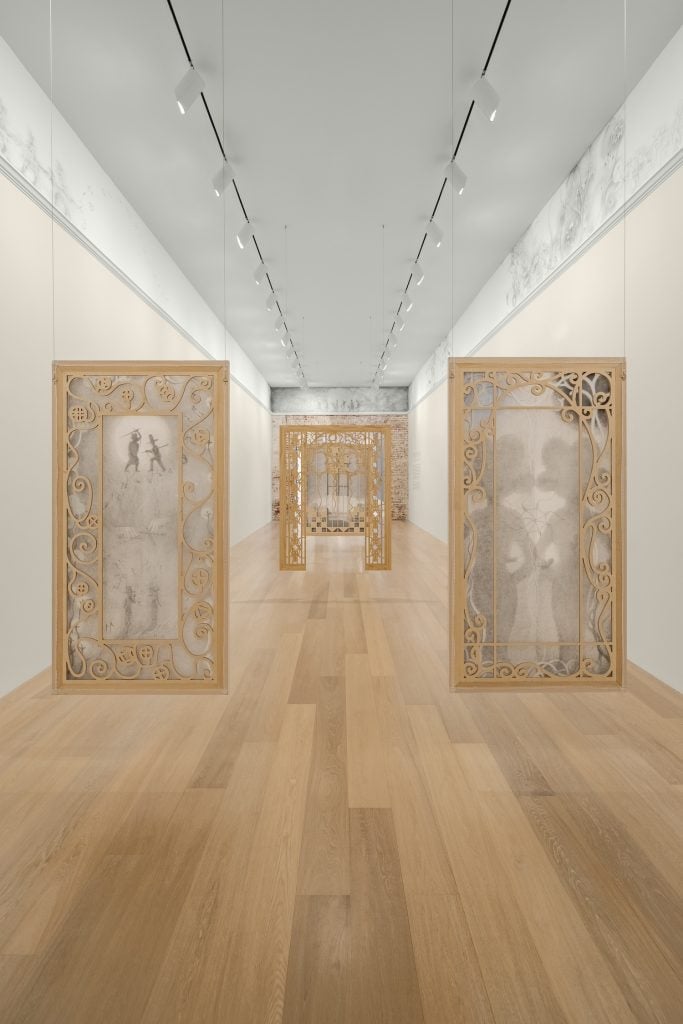
Installation view “Cindy Ji Hye Kim: Silhouettes in Lune” 2024. Courtesy of SCAD. Photography by Lance Brewer.
The artist’s mural in her SCAD Museum of Art exhibition additionally features kokdu, carved funerary figures intended to guide the dead to the afterlife in Korean tradition. Kim is also captivated by European funerary art objects and traditions, particularly the death masks of historical figures. “On a purely material front, the mask seems so insignificant compared to the person it depicts,” said the artist who hopes to continue exploring “this sense of material disconnection” in future projects.
As she prepares for several group shows in Asia later this year, Kim hopes visitors to Silhouettes in Lune leave feeling “enriched” by the experience. “If their dreams are more interesting, I won’t be disappointed.”